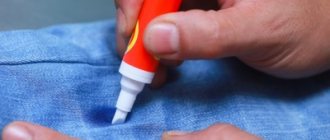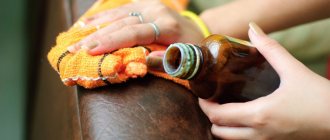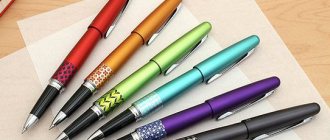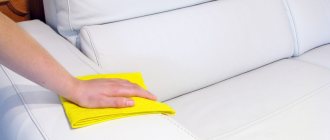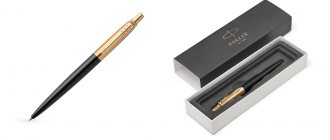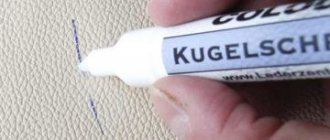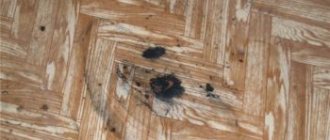Stylish, beautiful, expensive. The Parker fountain pen is a symbol of recognition and success. It is extremely valuable, and this value is not always measured in money. Therefore, any trouble with the pen is often perceived as a serious problem. To ensure that writing instruments from a well-known brand do not suffer from breakdowns and last a long time, you should follow simple rules for caring for them. There are only five of them:
- Keep your pen clean. Make sure that it is stored in a case and that no foreign objects that could damage the pen or body come into contact with the product.
- Be careful! When using a pen, be careful not to let it fall or throw it on the table. Otherwise, even an expensive product may simply break, because nothing lasts forever.
- Clean your pen regularly. To wipe the product, it is best to use a dry piece of natural fabric that does not cause static electricity. The use of cleaning products is completely excluded!
- Do not use paper towels to clean your pen. This may cause small particles of paper to clog the pen openings. The best option is cotton fabric.
- Clean your pen - at least monthly! In addition, flushing is required when replacing an ink container or to eliminate local problems - clogging of the channel or when the pen is left idle for a long time without use.
How to disassemble a fountain pen and remove the nib
I'll start with the most difficult thing, take out the pen and feeder. In most of the simplest Chinese pens, the nib and feeder are simply inserted with tension into the nib block.
We take the feather, the feeder on the index finger, press the feather with our thumb and pull it towards ourselves (if the feather has been washed). There are often nuances when the pen has been left unwashed for a long time, the ink has dried out, and in such cases it will be difficult to simply pull out the pen.
We do this:
- You can put the entire feather unit in water to soak for a couple of hours and then try to disassemble it.
- Method with glycerin.
Take glycerin and fill it into a syringe. In my case, a syringe with a dispenser attachment. We wet the feeder, preferably at the base of the feather block, you will need 4-6 drops.
Hold the pen in a vertical position with the nib facing up for 5-10 minutes. When droplets of glycerin seep inside the feather block, you can begin disassembling.
We make the movements described earlier, put the feeder on the index finger, press the feather with the thumb and pull it towards ourselves.
Everything comes out like clockwork.
Then we wash everything with water and dry it. If it is difficult to return everything back, you can also dip the feeder in glycerin and insert everything back, then rinse with water and dry.
This method is good because glycerin softens and prevents premature drying of the plastic parts of the handle.
You can also wash the pen with a solution of glycerin per 100 ml of water and 5-10 ml of glycerin.
How to remove a pen from a pen
Removing the old pen is your first step. Before you start the process, put on clothes that you don’t mind getting dirty, cover the table with paper or oilcloth, buy thin rubber gloves at the pharmacy - otherwise you risk staining everything around with ink, which is very difficult to wash off both skin and various surfaces. Especially if it is high-quality and durable ink.
To remove the pen, you must first unscrew the front cover on the body. Then grab the feather and rock it slightly from side to side. Doing this with your fingers is not very convenient, and it is also unsafe - the pen is very sharp, and you can get hurt. To remove the feather, it is best to use thin platypuses or at least pliers (very carefully so as not to damage the feeder).
You need to remove the pen together with the plastic support (feeder) on which it rests. Grab the very base of the pen with the tool, being careful not to touch the plastic ribs of the footrest so as not to break them during the removal process. If you damage them, you won't be able to replace the nib and the pen will likely have to be thrown away. The nibs on vintage pens hold tighter than modern ones, so you will have to use a little more force to remove them.
Keep this in mind when choosing vintage pens for everyday use.
How to replace a nib
The handle must be washed thoroughly and dried thoroughly in disassembled form. Now you need to assemble it. To do this, insert the new nib into the pen body in place of the old one, and then carefully turn it until it snaps into place. Next, you need to line up the channel on the tip of the pen. You can, of course, not waste time and just buy a new pen that will replace the old one. But if the old pen was dear to you, be sure to try to repair it.
There is another way to replace the pen using ordinary stationery tape. Use a cotton cloth to clean any ink from the pen. Once it is completely dry, apply some duct tape to it and pull the feather with it. Then rinse the pen in warm, but not hot, water.
If the pen is from the times of the USSR
- Immerse the handle in hot water for 5 minutes, but not in boiling water.
- Unscrew the reservoir (left-hand thread).
- Squeeze out the “internals”, that is, the feather-feeder-collector block inside the grip.
- Remove the feather from the feeder.
The rest is as needed. You can wash all the components, reduce the feather, clean the feeder and collector. Then put it back together as it was. If necessary, apply a small amount of silicone sealant to the threads. Then twist it.
If the pen has a pipette
- Immerse the pen in hot water for 5 minutes, but not in boiling water (grip only, do not lower the pipette)
- Unscrew the pipette (the thread is left-handed, very often on Chinese handles the nut with the pipette is plastic, work very carefully, do not squeeze the parts.)
- Squeeze out the “internals”, that is, the feather-feeder-collector block inside the grip
- Remove the feather from the feeder.
See the rest above.
As for unscrewing it in 5 minutes, it will only work with Soyuz and Sacco-Vanzetti handles. If you come across a Yaroslavl AR-36 with a step on the rear body - like white, then this is a problem, especially if it is NOS, which has been lying dry for 50 years - “Yaroslavl” at the time of the 36th used the most hellish mixture on bitumen of all the later Soviets.
For me, it twisted tolerably only after several days of soaking in Ariel-automatic powder - neither the heating battery nor the handle with the handle filled with water helped in any way in turning the bitumen on the thread - at most it was a turn of a couple of mm, just enough to start scroll the metal ring of the case...
AP36 is one of the first early piston engines - when it spun up, it showed that the bitumen had stupidly hardened to plastic - even a needle did not pierce it right through to the body - and this is because the bitumen had already been soaked with a surfactant, apparently the reason was NOS lying and drying out.
Unfortunately, you can’t use a crimp like pliers through a towel on the 36x - the plastic of the case is hardboard, and on the early ones it’s like translucent hardboard - much more fragile than on the later ones, it cracks very easily from any undistributed pressure on one point... Apparently, I’ll only unwind the next 36 after soaking in white spirit...
I don’t recommend disassembling the AR-36 at all unless absolutely necessary - like a carcass that dried out decades ago - it’s better to repeatedly soak it with automatic powder, soaking it in the powder for weeks, than just one inept disassembly and a crack in the body.
The ink is perfectly soaked with washing powder, without any disassembly of the handle - even the ribbed collector sleeve will be perfectly clean after several changes of the powder solution.
https://youtu.be/ybqz7HmdXO0
How to remove gel ink?
The gel from the pen tends to penetrate deeply into any porous surface, so the sooner the first steps to remove it are taken, the better.
There are only five basic rules:
To prevent a fresh stain from spreading over the surface, it is outlined with a paraffin candle. You should not go beyond these boundaries. Once the treatment is complete, the paraffin can be removed with an iron.- The cleaner should be applied along the edge of the stain, rubbing it towards the center.
- Gel pens can be alcohol- and water-soluble. If it cannot be removed with water, use alcohol-based formulations.
- Washing should be done in cool water.
- If possible, it is better to turn the item inside out.
Methods for removing traces of gel pen from various surfaces are described here.
How to clean a fountain pen. Questions and answers
show all points on the map of Moscow
st.
Aviamotornaya, 67/8, building 1, Moscow
st.
Saperny proezd, 6k1, Moscow
st.
Ramenki, 23 Moscow
Bagrationovsky Ave., 7 bldg.
20B (off. 4) Moscow
st.
Ivana Franko, 6, Moscow
st.
Osennyaya, 4, bldg. 1 (office No. P45.2) Moscow
st.
Pervomaiskaya, 1 Moscow
Pleteshkovsky lane, 7-9, building 1
Moscow
Shchelkovskoe highway, 29
Moscow
Bolshoi Sukharevsky lane, 15 b2
Moscow
st.
Generala Antonov, 3a, office. 2 Moscow
st.
Dmitry Ulyanov, 36, Moscow
st.
Kominterna, 4 (office 10) Moscow
st.
Studeny proezd, building 4 building 1, Moscow
st.
Profsoyuznaya, 45, Moscow
st.
Tarusskaya, 18k1 (office 6) Moscow
st.
Malomoskovskaya, 10 Moscow
3rd Avtozavodsky Ave., 4
Moscow
Andropov Ave., 15
Moscow
st.
Brateevskaya, 16, bldg. 6 Moscow
st.
Domodedovskaya, 20, building 1 (office 5) Moscow
st.
Kronstadtsky Blvd., 7A, entrance 3 (office 102) Moscow
Leningradsky Ave., 2, ground floor, office.
No. 1 Moscow
Leningradsky pr., 75A
Moscow
st.
Luganskaya, 5 (office 1) Moscow
6 Roshchinsky pr., 1, building 4
Moscow
st.
800th anniversary of Moscow, no. 18 (Beskudnikovo) Moscow
Balaklavsky pr., no. 5
Moscow
st.
Kirovogradskaya, 15 (Electronic Paradise shopping center, pavilion 1G-7) Moscow
Lokomotivny proezd 21 (office 104)
Moscow
st.
Novoslobodskaya, 31, building 4 Moscow
Ninth Company, 14
Moscow
Komsomolskaya sq., 6
Moscow
Luchnikov lane, 4, building 2, of.
22 Moscow
Leninsky Prospekt 71
Moscow
st.
Maria Polivanova, 9, Moscow
st.
Fightovaya house 8с3 Moscow
st.
Dinamovskaya, 1A, office. 110A Moscow
st.
Zelenodolskaya, 36, bldg. 2 (office 32) Moscow,
Kozhukhovo microdistrict, st.
Dmitrievskogo, 23 , Moscow
Nastasinsky lane, 8, building 2 (office 10)
Moscow
, st.
Nelidovskaya, 21, building 1, Moscow
st.
Svobody, 89, bldg. 5 Moscow
st.
Khlobystova, 12 Moscow
Khoroshevskoe highway, 43a
Moscow
st.
1st Yamskaya, 3/7 Moscow
st.
Guryanova, 30, basement, Surf Plaza, Moscow
st.
Dobrolyubova, 21A, bldg. A (office 5) Moscow
Myachkovsky Blvd., 11
Moscow
st.
Sergius of Radonezh, 31, Moscow
st.
Letnikovskaya, 4, building 2, Moscow
st.
2nd Vrazhsky lane, 5 Moscow
1st Magistralny proezd, 12, building 1
Aprelevka
st.
Parkovaya, 3 Balashikha
st.
Sovetskaya, 56 (ground floor) Butovo
st.
Kulikovskaya, 22 (metro station Dmitry Donskoy Boulevard) Vidnoye
st.
Donbasskaya d. 2 (off. 3, BC "YUG") Volokolamsk
st.
Panfilova, no. 5 (office 27, floor 1, shopping center "PODKOVA") Voskresensk
st.
Sovetskaya, building 2M , Dmitrov
st.
Moskovskaya, 3, Dolgoprudny
st.
Tsiolkovskogo, 34 , Domodedovo
microdistrict.
Central, Kirova street, 7/1 Dubna
Bogolyubova Ave., 16A
Zheleznodorozhny
st.
Oktyabrskaya, 25k1 (entrance behind the second entrance) Zhukovsky
st.
Luch, 20 , Zvenigorod
st.
Moskovskaya, no. 35A Zelenograd
Kryukovskaya square, no. 1A
Zelenograd
st.
Andreevka, 31/2, 1st floor (Andreevsky Furniture House), Istra
st.
Lenina, house 27 , Klin
st.
Sportivnaya, 15/1, Kolomna
st.
Zaitseva, 38, office 19 (1st floor) Korolev
st.
Kalinina, 6B (TC "Sigma" 1st floor, office 15) Korolev
st.
Svobodnaya, 1A Kotelniki
Novoryazanskoe highway, 6 (office 14)
Krasnogorsk
Opticheskiy lane, 1A (Teply Beton microdistrict)
Krasnogorsk
st.
Uspenskaya, 24 Lyubertsy
Oktyabrsky Prospekt, 145
Malakhovka village,
Bykovskoe highway, 37/5
Mitino
lane.
Angelov, house 8 , Mitino
st.
Mitinskaya, 42 (metro station Mitino) Mozhaisk
st.
Zhelyabova, 31, office. 1 Moskovsky
microdistrict 1, no. 52, room.
4 Mytishchi,
Moscow region, st.
Kolpakova, 9/2, Naro-Fominsk
sq.
Svobody, 1A Noginsk
Pozharny lane, 1 (entrance from the paid parking lot)
Odintsovo
, Moscow region, Mozhaiskoe highway, 13
Orekhovo-Zuevo
Moscow region, 1st Dzerzhinsky passage, 32
Ostrovtsy village,
Ramensky district.
st. Podmoskovnaya, 35 Pavlovsky Posad
Bolshoy Zheleznodorozhny Proezd, 21/2, office 2
Podolsk
Lenin Ave., 146, 1st floor, office.
101 Podolsk
st.
Vokzalnaya, 1, office. 1 (entrance from the yard) Pushkino
st.
Griboedova, 7, office. 101, 1st floor , Ramenskoye
st.
Mikhalevich, 51, Sergiev Posad
st.
Bolotnaya, 15 , Serpukhov
st.
Voroshilova, 60 Solnechnogorsk
st.
Lesnaya, 13 Solntsevo
st.
Glavmosstroy, 7 Stupino
st.
Gorkogo, 26, bldg. E, 1st floor, office 109 Tomilino
st.
Garshina, 11 Troitsk
st.
Police Colonel Kurochkina, 19, room 6 Khimki
Spartakovskaya, 11, office.
pom. 43 Khimki
st.
May 9, pavilion No. 3 , Chekhov
st.
Ilyich, 39 Elektrostal
st. Gorky, house 15
PenMania
It is an indisputable fact that a good (see Remark 1) fountain pen glides easily across the paper, requiring virtually no pressure. Your hand will not get tired and you will be able to write for hours (for those who need it) without fatigue. This fact is especially noticeable to those who switched to writing with a pen, and then happened to write something with a “ball”. Oh how annoying this is.
But! There are good ballpoint pens/refills and there are also mediocre fountain pens. About them - separately, not in this article.
Fountain pen is health
Many of us spend a lot or a lot of time in front of a monitor and keyboard with a mouse. Many are at risk of developing carpal tunnel syndrome due to fairly monotonous hand movements when working on a computer.
I know of at least one case, probably more, where a professional “keyboard worker” was able to recover from carpal tunnel syndrome by trying to write with a pen and making a rule for himself regularly, once a day, to write something with a fountain pen on an A4 sheet of paper.
The recovery is due to the fact that when writing with a pen, the hand makes smooth movements, which are radically different from the movement when working with a mouse and keyboard.
A fountain pen is stylish
The traditions of fountain pen production are based on hundreds of years of experience. Pay attention to the care and taste with which good pens are made. They are simply pleasant to hold in your hand. And if a neighbor in the lecture hall or a work colleague sees such a pen in your hands, you are guaranteed [respectful] attention.
You can choose a handle for yourself with either a conservative timeless design or
as well as with a modern technocratic appearance. According to your style.
Writing with a pen is economical
If you write a lot as part of your academic or professional duties, then most likely you write dozens of ballpoints per year. A ballpoint rod of acceptable quality costs 40-60 rubles (we are talking, for example, about rods made in Japan by Pilot, Pentel, Zebra and the like) (see Remark 2). The total amount adds up to 1000 rubles per year.
Good quality Parker and Waterman inks in the size of two bottles will more than cover your annual needs. And they will cost you only 200-350 rubles per bottle.
And if you use good Rainbow ink for 20-30 rubles per bottle... the benefits are off the charts.
The pen forms (with your help) beautiful handwriting
Why do you need this? In addition to the aesthetic satisfaction of the work you have done, clear, neat, stylish handwriting can serve you well when submitting an application somewhere, highlighting yours among others with similar content. Perhaps this will change your life...
Widest selection of ink colors
You can choose the color of ink to suit your mood, the color of your tie or handbag, the color of the pen itself, the color of your eyes, etc. Take a look at just a selection of colors from just one ink company, Diamine.
This is difficult to do when choosing colors for a ballpoint pen.
Feather is a new sensation every day
Most fountain pens write differently. This applies to the thickness of the nib and line, the saturation of the line, the elasticity of the nib, the shape of the nib, the shape of the pen and the material from which it is made.
You can choose one pen with which you will write constantly and which suits you best.
Or you can collect a small collection of several pens and change them every day (week, month) and get new sensations from part of your activity (writing) every time you change your writing instrument.
This is not so easy to do with a ballpoint pen and rollerballs.
Contraindication 1
You don’t want to “bother” with choosing a pen, refilling ink or ink cartridges, improving your handwriting, and generally don’t bother with any issues in your life. Then don't waste your time and don't bother. The pen is not for you. Bye.
Contraindication 2
You write a lot on forms that require firm pressure from the writing unit in order to make a copy through the carbon paper. Or you write a lot on bad paper, on which any ink simply bleeds (again, some blank forms).
Parker pen is dry - what to do?
Fountain pens are very popular today. And if we are talking about Parker products, then such popularity has not subsided for a hundred years. No one doubts the quality of this brand’s products, as it has been proven by time. But feather models are those products that require special care and maintenance, unlike ballpoint and rollerball models. Errors in care and failure to follow simple operating rules can lead to the pen stopping writing. What to do if your Parker pen is dry?
5% discount For readers of our blog 5% discount
for the entire range Your promotional code: BLOG See all pens
Rules for using and caring for a fountain pen
If you have decided to buy a fountain pen , then you have probably read a lot of useful articles about the advantages of this wonderful tool for handwriting compared to other types of pens. Your desire to improve your handwriting and achieve calligraphic perfection is completely justified. After all, prolonged use of a fountain pen not only develops beautiful handwriting, but also teaches you to write neatly.
As a result, you will receive true pleasure both from the writing process itself and from contemplating the work itself. Writing with ink or ink is like going through a relaxation session. Since ancient times in China, writing characters in calligraphic handwriting has been considered a calming process. And our psychologists recommend taking a sheet of paper and writing by hand everything that hurts in your soul, carefully writing out each letter.
This procedure gives confidence and has a wonderful effect on an excited person, relieving nervous tension. In general, writing with a pen will allow you to achieve inner harmony.
And yet, if you have picked up a fountain pen for the first time, then, of course, you will have simple questions:
- How to use a fountain pen correctly?
- How to refill a fountain pen correctly?
- How to properly hold a fountain pen in your hand?
- How to store a fountain pen?
- How to properly wash a fountain pen?
In the old days, even junior schoolchildren could answer such questions. In penmanship classes, students learned how to use an ink pen and how to write correctly with a fountain pen. Now, a little educational program will not hurt adult owners of a newly purchased fountain pen.
How to refill a fountain pen correctly
Prepare in advance to refill your fountain pen. You should have a pen, dry wipes, a bottle of ink, a protective mat or a sheet of paper on hand so as not to accidentally stain the table. There are several ways to refill a pen. It all depends on what type of pen you choose.
If you have a pen with a cartridge refilling system, you can simply replace the spent cartridge with a new one. In essence, the clue to how to refill a fountain pen with ink is contained in the very design of your pen's refilling system. These can be pipette, snorkel (from German.
Schnorchel - tube), lever and other filling systems.
The classic piston filling system is the most common option. For example, the pens of the German companies Pelikan and Graf Von Faber-Castell use just such a filling scheme. And it was developed and patented by the inventor Theodor Kovacs (Hungary) back in 1920. You need to dip the bottom of the nib pen into the ink and rotate the top of the pen clockwise. Thanks to the threads on the axis, the piston will begin to move and the reservoir will fill with ink. After refilling is complete, you need to wipe the nib and pen clean of ink. You now know how to refill an ink pen.
How to use a fountain pen so that it serves you long and reliably
You just need to follow simple rules for using and caring for it.
First, the type of cartridge or ink must match your pen model. This will allow you to avoid damage to the mechanism due to low-quality ink, which can clog the capillary system. Reputable fountain pen manufacturing companies take care of the “reputation” of their products and produce high-quality ink for them.
Secondly, always keep the pen clean; when not in use, the cap should be closed.
Third, choose the right pen. If you want to get a fine line, a wide nib will not suit you. Pen nibs differ in size and shape, which makes it possible to choose a standard width: B (wide), M (medium), F (thin), which is suitable for you. This will allow you to avoid inconvenience when writing, when, with effort, you can simply ruin the pen. The pen should glide easily over the paper, and your hand should not get tired.
How to hold a fountain pen so that the lines fall smoothly and evenly
The pen must be held correctly. Remember that the angle of the pen affects the width of the line. Angle the pen as needed so that the pen glides across the paper and leaves the line width you need.
At the same time, place the pen on your middle finger, and with your thumb and index finger, grab the pen from above so that there is a distance of no more than one and a half centimeters between the tip of the middle finger and the index finger. This way your hand won't strain. The emphasis is on the little finger, wrist and outer edge of the palm. Lightly press the pen if you need a thicker line.
That's all the “wisdom” on the way to developing beautiful handwriting. Patience and a little effort! If you are persistent and write a lot, you will achieve perfection in calligraphy.
How to store a fountain pen
Store a refilled fountain pen correctly in a horizontal position - this will allow the pen to dry out more slowly. If you plan not to write with a pen for a long time (more than a month), then drain the ink from the pen/remove the cartridge, rinse the pen thoroughly under running water, dry it and leave it lying there without ink. Storing the pen in the sun is strictly prohibited! You can solve the issue of storing a fountain pen if you purchase a special leather pencil case.
